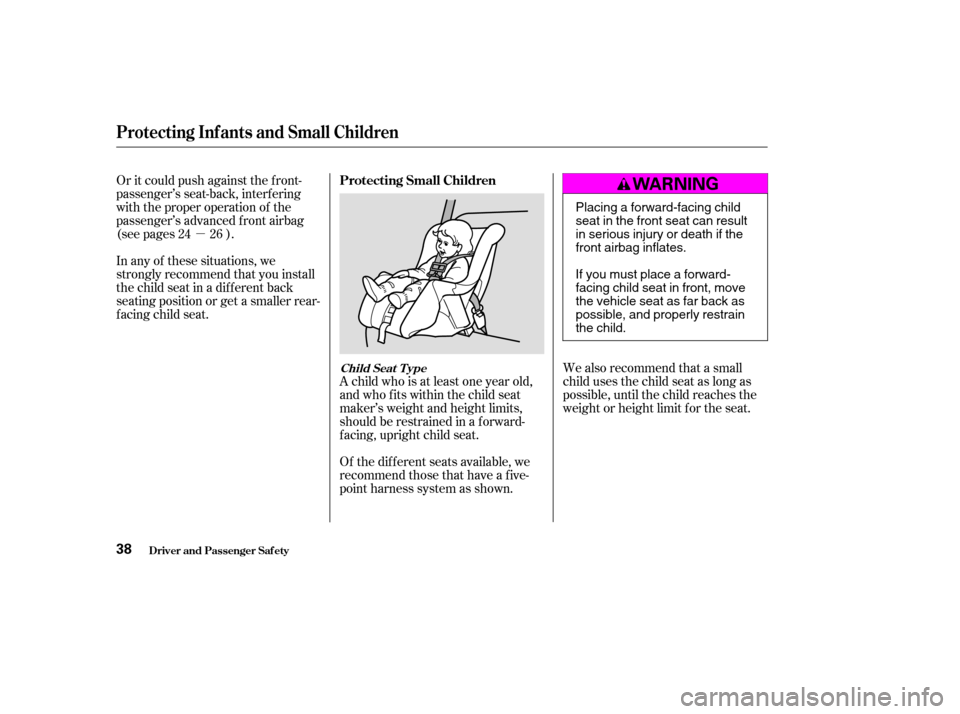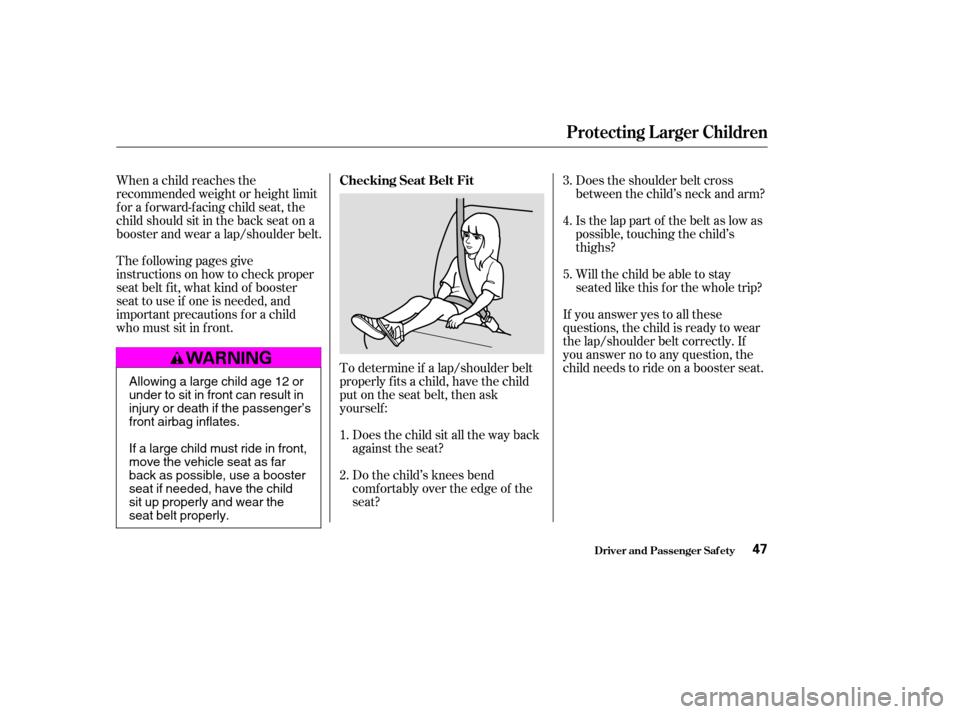Page 32 of 313

�µ
�µ
According to accident statistics,
children of all ages and sizes are
saf er when they are restrained in the
back seat. The National Highway
Traffic Safety Administration and
Transport Canada recommend that
all children age 12 and under be
properly restrained in the back seat.
Children who ride in back are less
likely to be injured by striking
interior vehicle parts during a
collision or hard braking. Also,
children cannot be injured by an
inf lating airbag when they ride in the
back. Front airbags have been designed to
help protect adults in a moderate to
severe f rontal collision. To do this
the passenger’s f ront airbag is quite
large and it can inf late with enough
f orce to cause very serious injuries.
To help prevent airbag-caused
injuries to children, this vehicle has
an advanced airbag system.
With this system, the front
passenger’s airbag is turned of f if
sensors detect a total weight of less
thanabout65lbs(30kg)ontheseat
(see pages f or additional
inf ormation about how the f ront
passenger’s advanced airbag works).
Even if the passenger’s f ront airbag
is turned of f , we strongly
recommend that children age 12 and
under ride properly restrained in a
back seat where they will be saf er.
24 26
CONT INUED
Protecting Children General Guidelines
Driver and Passenger Saf ety
All Children Should Sit in the
Back Seat
The Passenger’s Front Airbag
Can Pose Serious Risks
33
�����—�����—�����y�
���������
�
�y���
�(���%���
���y���������y
Page 33 of 313
�µ
To remind you of the passenger’s
f ront airbag hazards, and that
children must be properly restrained
in the back seat, your vehicle has
warninglabelsonthedashboardand
on the driver’s and f ront passenger’s
visors. Please read and f ollow the
instructions on these labels.To remind you of the f ront airbag
hazards, your vehicle has warning
labels on the driver’s and f ront
passenger’s visors. Please read and
f ollow the instructions on these
labels.
Protecting Children General Guidelines
Driver and Passenger Saf ety
U.S. Models Canadian Models
34
�����—�����—�����y�
�������������y���
�(���%���
���y���������y
Page 36 of 313

Only a rear-f acing child seat provides
proper support f or a baby’s head,
neck, and back.Two types of seats may be used: a
seat designed exclusively f or inf ants,
or a convertible seat used in the rear-
f acing, reclining mode.
An inf ant must be properly
restrained in a rear-f acing, reclining
child seat until the child reaches the
seat maker’s weight or height limit
f or the seat, and the child is at least
one year old. If placed
f acing f orward, an inf ant could be
very seriously injured during a
f rontal collision. A rear-f acing child seat should
always be installed in a back seat, not
in the f ront. Even with adbanced
airbags, which can automatically
turn the passenger’s f ront airbag of f
(see page ), a back seat is the
saf est place f or an inf ant.
When properly installed, a rear-
f acing child seat may prevent the
driver or a f ront passenger f rom
moving the seat as far back as
recommended, or f rom locking the
seat-back in the desired position.
24
CONT INUED
Protecting Inf ants and Small Children
Driver and Passenger Saf ety
Protecting Inf ants
Child Seat T ype
Do not put a rear-f acing child seat ina f orward-f acing position. Child Seat Placement
37
Placing a rear-facing child seat
in the front seat can result in
serious injury or death during acollision.
Always place a rear-facing child
seat in the back seat, not thefront.
�����—�����—�����y�
�������������y���
�(���%���
���y���������y
Page 37 of 313

�µWe also recommend that a small
child uses the child seat as long as
possible, until the child reaches the
weight or height limit f or the seat.
A child who is at least one year old,
and who fits within the child seat
maker’s weight and height limits,
should be restrained in a f orward-
f acing, upright child seat.
Of the different seats available, we
recommend those that have a f ive-
point harness system as shown.
Or it could push against the f ront-
passenger’s seat-back, interf ering
with the proper operation of the
passenger’s advanced front airbag
(see pages ).
In any of these situations, we
strongly recommend that you install
the child seat in a dif f erent back
seating position or get a smaller rear-
f acing child seat.
24 26
Protecting Inf ants and Small Children
Driver and Passenger Saf ety
Protecting Small Children
Child Seat T ype
38
Placing a forward-facing child
seat in the front seat can result
in serious injury or death if the
front airbag inflates.
Ifyoumustplaceaforward-
facing child seat in front, move
the vehicle seat as far back as
possible, and properly restrain
the child.
�����—�����—�����y�
�������������y���
�(���%���
���y�������
�y
Page 38 of 313

We strongly recommend placing a
forward-facing child seat in a back
seat,notthefront.Evenwith
advanced airbags, which can
automatically turn the passenger’s
front airbag off (see page ), a
back seat is the safest place for a
small child.
If it is necessary to put a f orward-
f acing child seat in the f ront, move
the vehicle seat as far to the rear as
possible, be sure the child seat is
f irmly secured to the vehicle, and the
child is properly strapped in the seat.When buying a child seat, you need
to choose between a conventional
child seat, or one designed f or use
with the Lower Anchors and Tethers
f or Children (LATCH) system.
Conventional child seats must be
secured to a vehicle with a seat belt,
whereas LATCH-compatible seats
are secured by attaching the seat to
hardware built into the two outer
seating positions in the back seat.
Since LATCH-compatible child seats
are easier to install and reduce the
possibility of improper installation,
we recommend selecting this style.
We also recommend selecting a
LATCH-compatible seat with a rigid,
rather than a f lexible, anchor (see
page ).In seating positions and vehicles not
equipped with LATCH, a LATCH-
compatible child seat can be installed
using a seat belt.
24
41
Protecting Inf ants and Small Children, Selecting a Child Seat
Driver and Passenger Saf ety
Child Seat PlacementSelecting a Child Seat
39
�����—�����—�����y�
���������
���y���
�(���%���
���y���������y
Page 46 of 313

When a child reaches the
recommended weight or height limit
for a forward-facing child seat, the
child should sit in the back seat on a
booster and wear a lap/shoulder belt.To determine if a lap/shoulder belt
properly f its a child, have the child
put on the seat belt, then ask
yourself :Does the child sit all the way back
against the seat?
Do the child’s knees bend
comf ortably over the edge of the
seat? Does the shoulder belt cross
between the child’s neck and arm?
Is the lap part of the belt as low as
possible, touching the child’s
thighs?
Will the child be able to stay
seated like this f or the whole trip?
The f ollowing pages give
instructions on how to check proper
seat belt f it, what kind of booster
seat to use if one is needed, and
important precautions f or a child
who must sit in f ront.
If you answer yes to all these
questions, the child is ready to wear
the lap/shoulder belt correctly. If
you answer no to any question, the
child needs to ride on a booster seat.
1. 2. 3.4. 5.
Protecting L arger Children
Driver and Passenger Saf ety
Checking Seat Belt Fit
47
Allowing a large child age 12 or
under to sit in front can result in
injury or death if the passenger’s
front airbag inflates.
If a large child must ride in front,
move the vehicle seat as far
back as possible, use a booster
seat if needed, have the child
sit up properly and wear the
seat belt properly.
�����—�����—�����y�
�����������
�y���
�(���%���
���y���������y
Page 47 of 313

A child who has outgrown a forward-
f acing child seat should ride in the
back seat and use a booster seat
until the lap/shoulder belt f its them
properly without the booster.
Some states also require children to
use a booster until they reach a
given age or weight (e.g., 6 years or
60lbs).Besuretocheckcurrent
laws in the state or states where you
intend to drive.The National Highway Traffic Safety
Administration and Transport
Canada recommend that all children
ages 12 and under be properly
restrained in the back seat.
Even with advanced front airbag, the
back seat is the safest place for a
child of any age or size.
If the passenger’s f ront airbag is on,
and it inflates in a moderate to
severe f rontal collision, the airbag
can cause serious injuries to a child
who is unrestrained, improperly
restrained, sitting too close to the
airbag, or out of position.
The side airbag also poses risks. If
any part of a larger child’s body is in
the path of a deploying side airbag,
the child could receive possibly
serious injuries.
Booster seats can be high-back or
low-back. Whichever style you select,
make sure the booster meets f ederal
saf ety standards (see page ) and
that you f ollow the booster seat
maker’s instructions.
If a child who uses a booster must
ride in f ront, move the vehicle seat
as far to the rear as possible, and be
sure the child is wearing the seat
belt properly.
A child may continue using a booster
seat until the tops of their ears are
even with the top of the vehicle’s or
booster’s seat-back. A child of this
height should be tall enough to use
the lap/shoulder belt without a
booster.
40
Protecting L arger Children
Driver and Passenger Saf ety
Using a Booster Seat
When Can a L arger Child Sit in
Front
48
�����—�����—�����y�
�������������y���
�(���%���
���y�������
�y
Page 51 of 313
These labels are in the locations
shown. They warn you of potential
hazards that could cause serious
injury. Read these labels caref ully.
If a label comes of f or becomes hard
to read (except for the U.S.
dashboard label which is removed by
the owner), contact your Honda
dealer f or a replacement.
U.S. modelsCanadian models U.S. models only
On models without side airbags On models with side airbags On models with side
curtain airbags
Saf ety L abels
Driver and Passenger Saf ety52
HOOD DASHBOARD
RADIATOR CAP
�����—�����—�����y�
�������������y���
�(���%���
���y���������y